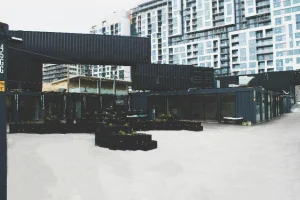Choosing the Optimal Container House Size: A Comprehensive Guide
Choosing the Optimal Container House Size: A Comprehensive Guide
When deciding on the size of a container home to buy or build, you should take into account the typical dimensions available, the options for personalizing it according to your tastes and needs, the financial limitations you may have, and the space you have. Additionally, you should think about how many people will live in it, the ease of access to the location and the weather conditions that may affect its size. By considering all these factors, you can make a thought-out choice and create a valuable and eco-friendly container home.
Container House Sizes
Standard Container Dimensions
When deciding the size of a container house to go with, initially look at the dimensions of the containers first and foremost. The common sizes for containers are usually 20 feet or 40 feet long. These dimensions are uniform over the world and serve as a good starting point for your project. The 20-foot container offers about 160 feet of area, while the 40-foot one gives you double that space at approximately 320 square feet. These sizes work well for living areas or single-room setups.
Custom Container Options
Modifications for Unique Needs
Looking to go beyond the sizes? You can opt for container choices that cater to your specific needs by adjusting the length or width according to what you require. Be it for extra storage space or customized equipment accommodations, to craft a living area that suits you perfectly.
GSMOD‘s Custom Solutions
GSMOD provides solutions for individuals who desire customized options for their residences or buildings. This company’s proficiency in crafting container homes guarantees that they can meet your exact requirements with accuracy and excellence. By prioritizing longevity and security in their designs, the buildings incorporate cold-formed galvanized steel elements with high strength to enhance structural integrity against natural disasters, such as earthquakes and strong winds.
Factors Influencing Container House Size Selection
Budget Constraints
When choosing the size of a container home, it’s crucial to keep your budget in mind, as larger containers and fancy modifications can drive up expenses considerably. This means finding a size that meets your needs while staying within your means for a practical and cost-effective outcome.
Space Requirements and Usage
Family Size Considerations
The size of a container house is influenced by the number of people living in it, with larger families needing space to ensure comfort and practicality in their living arrangements. It’s important to take into account both present and future family requirements when deciding on the right size for the home.
Intended Purpose of the Container House
The purpose for which the container house is intended also influences the choice of size significantly. Depending on whether it’s for living quarters office space or storage purposes, different spatial needs are required for each use case. Customizing the size based on its intended function guarantees usability and effectiveness.
Evaluating Site and Location Considerations
Site Accessibility and Regulations
When deciding on the size of your container house, consider factors like site accessibility and local regulations. Certain areas may have limits on building dimensions or demand permits for changes. Being aware of these elements from the start can help avoid alterations later on.
Climate and Environmental Impact
Insulation Needs Based on Climate
The climate plays a role in determining how much insulation your container house needs to stay cozy inside it. If you’re in a cold area, you’ll need thicker insulation to keep things comfortable indoors. GSMOD offers walls with built-in insulation made of hydrophobic basalt wool that ranges from 50 to 120mm thick, perfect for various environments.
Eco-Friendly Solutions by GSMOD
If you regard sustainability as a priority in construction projects, GSMOD provides eco-conscious solutions that comply with eco-friendly building standards. Their buildings incorporate energy-efficient blueprints and materials to lessen their ecological footprint while upholding top-notch quality measures.
Selecting the size for a container house requires thoughtful assessment of different aspects, such as standard measurements, available options for customization, financial limitations, space needs depending on family size and planned purpose, and site-specific factors like ease of access and environmental influences. By utilizing professional services from companies like GSMOD, you can strike a harmonious blend of practicality, affordability, and eco-friendliness in your pre-built housing venture.
Designing for Functionality and Comfort
When it comes to container homes, design considerations focus on both functionality and comfort are aspects that need attention to detail and care in the customization process of these homes for adaptability and versatility in facilities where they are placed for specific layouts and requirements in terms of size, color, and purpose tailored to suit individual preferences and needs.
Interior Layout Planning
Maximizing Space Efficiency
When you’re designing the layout for your container homes, space is key – make sure to maximize every inch! Make the most of your space by using furniture that serves more than one purpose and arranging storage solutions strategically throughout the home. To save space when furniture is not needed, consider using pieces that can fold or retract into sizes. Furthermore, placing shelves and cabinets at heights can help you make the most of vertical space in your home.
Incorporating Essential Amenities
Ensuring your container home has all the necessary amenities is vital for its functionality and comfortability. To achieve this goal, you should include an equipped kitchen, ample bathroom features, and suitable sleeping areas in the initial design stages to seamlessly integrate them into the available space.
Enhancing Aesthetic Appeal
Exterior Design Options
The outer look of your container home is crucial for its attractiveness and charm. There are ways to boost its visual appeal, like putting on cladding or painting it in lively hues and including big windows for natural light. These additions not only make it more visually appealing but also help in saving energy by utilizing natural daylight effectively.
GSMOD‘s Design Innovations
GSMOD is at the forefront of design innovations in container housing. Their structures are crafted with high-strength cold-formed galvanized steel components that offer excellent structural properties like earthquake and wind resistance. The wall panel system features an outer board of 0.5mm thick galvanized color steel plate with zinc content ≥40g/㎡, ensuring anti-fading and anti-rust for 20 years, enhancing both durability and appearance.
Future-Proofing Your Container House Investment
Investing in a container home with an eye toward the future is a decision to secure lasting value and flexibility. It’s important to future-proof your container home investment to maintain its eco-friendliness.
Scalability and Flexibility
Expansion Possibilities with Modular Designs
Container homes with designs provide an excellent option for expanding your living space effectively and effortlessly as your requirements evolve without the hassle of major renovations.
Adapting to Changing Needs Over Time
Life situations can change over time, so can your housing requirements change accordingly? A crafted container home can easily adjust to these shifts by providing flexible layouts to accommodate various needs, such as turning a bedroom into a workspace or creating more space for a growing family.
Resale Value Considerations
Market Trends in Container Homes
The current trends in container homes suggest an increasing fascination with friendly and budget-friendly housing solutions is on the rise. The inclusion of features and creative designs in a container house can elevate its resale value, making it an appealing choice for potential buyers who value sustainable living practices.
Quality Assurance with GSMOD Products
GSMOD prides itself on maintaining top-notch quality in its buildings to ensure they meet strict safety and performance criteria before being released to the market. Their container homes undergo testing for air-sealing properties as well as their ability to bear loads and resist water and fire. These assessments are in place to assure customers that they will receive a product that not only satisfies but surpasses industry standards.
When deciding on the size for your container house investment, please put GSMOD’s options in mind, focusing on functional interior layout planning and attractive exterior design improvements while keeping scalability and adaptability to changing needs in check. It’s essential to consider market trends and ensure top-notch quality assurance for a well-informed choice.





